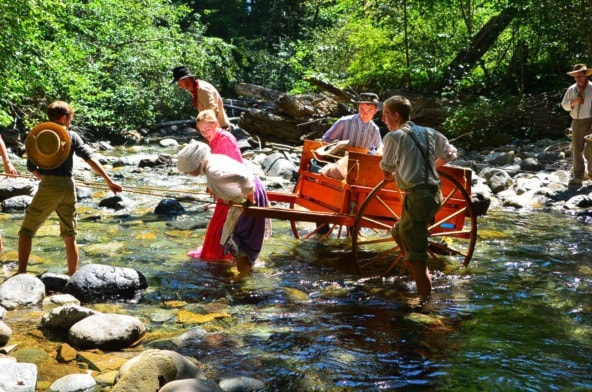Cart wheels rumble, the sun beats down and occasionally metal plates or cups clank and rattle as they fall onto the ground.
Young members of the Church of Jesus Christ of Latter-day Saints wipe sweat from their brows and fan their faces with wide-brimmed hats as a break is called.
The walkers – dressed in 19th century clothing styles – crowd around water jugs seeking solace from the hot summer sun and the kilometres of road they have traversed.
For four days, a group of Comox Valley youths and 70 other Vancouver Island teenagers re-enacted one of the epic pioneer journeys of North American history.
Youth members of the LDS Church aged 12 to 18 from six Vancouver Island wards (congregations) walked for 39.2 kilometres along logging roads and trails near Port Alberni pulling all their camping gear in two-wheeled handcarts.
"If we don't do things that are tough, we won't know what tough is," Trail Boss Harry Slobodan told the youths at an assembly after the first day of walking. Slobodan is a Nanaimo resident and a leader in the LDS Church's Nanaimo Stake presidency which includes the congregations on Vancouver Island from Duncan to Port Hardy and Powell River.
The Pioneer Trek is held every four years to commemorate the Latter-day Saints' exodus from Illinois across the American plains to the Salt Lake Valley in Utah to escape religious persecution and establish a community in the wilderness in the 1850s and 60s. The original handcart pioneers were following the plan of then-church President Brigham Young who had decided to switch from travelling in wagon trains and have the LDS migrants walk across the plains with carts pulled by hand because it was quicker and less costly.
The arduous journey was made by thousands of church members in searing heat and freezing cold to establish a community in the Utah desert where they could practice their religion free from harassment.
The church has since grown from its Utah base to establish itself worldwide, including on Vancouver Island and the rest of British Columbia. The quadrennial youth Pioneer Trek was started as a way to help the youth experience the outdoors, facing physical and mental challenges along the way, Slobodan said.
"We hope that they can gain confidence, make new friends, and learn to work together as a group," he said.
The trek involves seven families of about 10 youths and two adult "Ma's and Pa's" (married couples who volunteer to take on the roles of the groups' parents) who push and pull a handcart for 39.2 kilometres over four days along the back roads of the Alberni Valley. Along the way they cross creeks, climb hills, endure heat and dust and even cross a raised train bed that, coming on the last day of the trek, must have felt like climbing a mountain.
"We want you to learn how strong you are," Nanaimo Stake President Collin Van Horne told the youths. "We want you to understand what you're capable of…and that's anything!"
The trek sets off from near Browns Bay on Central Lake for a 12.2 km march on the first day on the Ash River Road before making camp the first night at the Ash River gravel pit. On the second day the youths walked 15 km. to the Beaver Creek area and made camp in the back acres of the Van Horne family's farm. Here they stayed for two nights, spending the next day participating in traditional competitions like sack races, stilt walking, caber tossing, hay bale stacking, two-handed sawing, and, of course, cart racing.
A special part of the in-camp day involved a Pony Express delivery on horseback of letters to the youths from their real families. They then spent some time reading the letters, writing in journals and reflecting quietly.
The evening was spent at a hoedown involving traditional 19th Century style dances and singing.
On the fourth day, the handcarts were packed up again and the families set off down the Log Train Trail for the last 12 km of the trek to the Mclean Saw Mill National Historic Site where, exhausted, they climbed aboard the Alberni Pacific steam train for a well-deserved ride back into Port Alberni and their awaiting families.
The trek sends the message to the youths that they are able to accomplish great things if they set their minds to it. They also learn to work as a team and get along with others. The sacrifice the church's pioneers made to establish their religion is also brought home to the youths in a tangible way.
"We hope they gain an appreciation of the sacrifice that the Mormon pioneers made as they migrated to the Great Salt Lake Valley," Slobodan said. "The Church as a whole cares deeply about the youth. We feel that an experience like Trek will strengthen and educate them in their cultural history. If the youth are strong and faithful, the church obviously benefits by having future leaders and dedicated members. The church also emphasizes the need for people to be helpful, contributing members of society and the Trek experience promotes that idea."
— Church of Jesus Christ of Latter-day Saints
